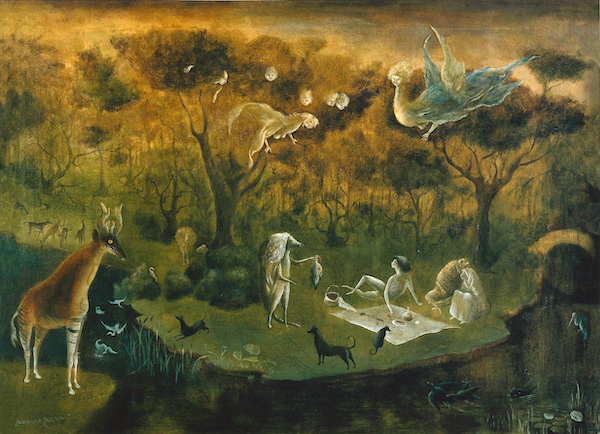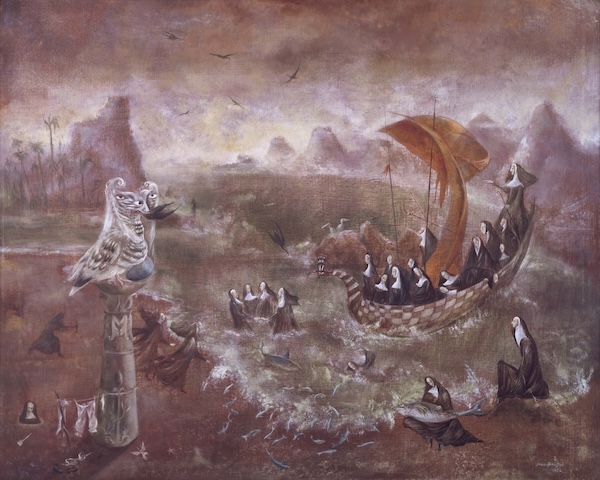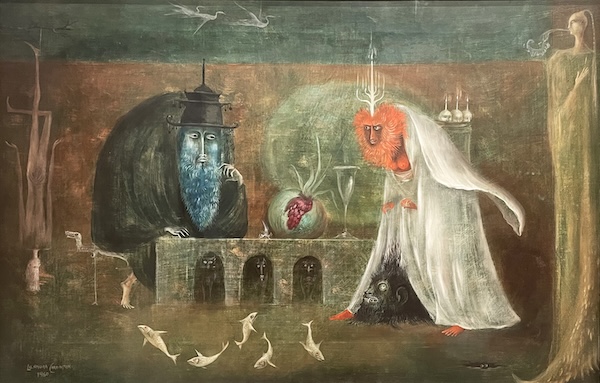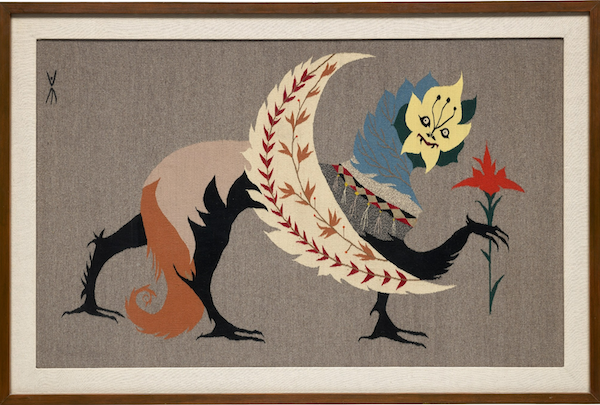Visual Arts Review: “Leonora Carrington: Dream Weaver” — Surrealist Sorcery
By Lauren Kaufmann
Reluctant to explain the meaning of her art, Leonora Carrington chose to let the magic and mystery of her inner life reveal itself through the imaginary animal/human creatures and fantastic landscapes of her paintings.
Leonora Carrington: Dream Weaver at the Rose Art Museum through June 1

Leonora Carrington, Pastoral, 1950, oil on canvas. Private collection.
For hundreds of years, the work of women artists has been neglected. It is only recently that their accomplishments have gotten the attention they deserve. Art historian Katy Hessel wrote a book last year — The Story of Art Without Men — that shines a much-needed light on the work of women artists, starting in the Renaissance and going up to the present. In it, she notes that a 2019 study found that in the collections of 18 major American art museums, 87 percent of the artwork was created by men.
So, our museums have a lot of catching up to do, because there are many talented women artists whose work merits our attention. One woman who’s getting her due, albeit posthumously, is Leonora Carrington. If you’re wondering who she is, you’re not alone. Leonora Carrington: Dream Weaver is her first solo exhibition in New England.
With more than 30 works of art, the exhibition is a potent brew of feminism, magical animals, and mystery. It reveals Carrington’s lifelong quest to understand and express that which remains unseen — the dreams, fairies, and fantasies that hover at the edges of our waking minds.
Carrington (1917-2011) grew up in Lancashire, England, in a wealthy family. As a child, she loved fairy tales and Irish fables and was influenced by the writing of Lewis Carroll, Jonathan Swift, and Beatrix Potter. Carrington’s passions were supported by her Irish grandmother, her mother, and her nanny, who all encouraged her imagination. She rebelled against the Roman Catholic boarding schools that her father sent her to, and she repudiated the debutante balls that her parents believed were critical to her future.
After her coming out party in London, Carrington announced to her father that she had fallen in love with Surrealist painter Max Ernst and planned to move to Paris to pursue a career as an artist. Her father forbade her from ever visiting him again and wrongly predicted that she would die penniless. Carrington never saw her father again, but she did not die a pauper.
Carrington’s father, a self-made millionaire, earned his riches from a Lancashire textile mill. Hence, the notion of weaving played an influential role early in Leonora’s life. While her father profited from his lucrative textile business, Leonora was more interested in creating art that wove together the visual threads that she found in her unconscious.
Living in Paris in the ’30s, Carrington befriended several prominent Surrealist artists, whose affinity for dreamy and incongruous imagery resonated with her own predilection for drawing on her subconscious. Her circle included Salvador Dalí, Man Ray, and André Breton. Carrington’s relationship with Ernst ended when he was captured and imprisoned by the Vichy government in 1938. Carrington escaped to Spain, where she ended up being treated for a nervous breakdown in a psychiatric hospital.
After being discharged from the hospital, Carrington married a Mexican diplomat, Renato Leduc. In 1942 the two moved to Mexico, where Carrington remained for the rest of her life. She became part of a coterie of artists and writers who escaped the perils of war-torn Europe during the ’40s. Among her friends were Mexican writer Octavio Paz and artists Frida Kahlo and Diego Rivera.
The exhibition at the Rose Art Museum reveals the deep well of Carrington’s fantastical imagination. She once described herself as a “female human animal,” a phrase that encapsulates her emphasis on her feminist identity, as well as her high regard for animal life. Nearly every painting and sketch in the show contains some form of animal or animal spirit.

Leonora Carrington, Nunscape at Manzanillo, 1956, oil on canvas. Private collection. Photo: courtesy of Rose Art Museum
In Nunscape at Manzanillo, a painting from 1956, Carrington reenvisions the nuns who tormented her during her youth. But here their lives are endangered as they try to survive roiling waters in an open boat. Some of the nuns seem safe, but others appear to be drowning. In the foreground, a school of fish circles around; a strange, three-eyed monster looms ominously over the chaotic scene. Birds swoop through the air, laundry hangs on a rope, and a pair of abandoned shoes lie in the corner. The gray-brown tones reflect Carrington’s troubled feelings about her Catholic upbringing.
The Last Resort (1954) shows a partridge in front of a doorway, a scorpion on the left side of the door, and a guardian angel looming over the door. The wall text informs us that the doorway belonged to Carrington’s friend, photographer Kati Horna, who fled from Hungary to Mexico during World War II. The image of the partridge harkens back to Carrington’s childhood in England, where the bird was a staple of British hunting culture. The doorway serves as a bridge to Carrington’s friendship with Horna.
The exhibition features a glass case with several photos that Horna took of Carrington. There’s a wonderful black-and-white image of Carrington working on Nunscape at Manzanillo in her studio. The photos are a great addition to the exhibit, giving visitors a visual image of the artist.

Leonora Carrington, Rabinos (The Rabbis), 1960, oil on canvas. Private collection, Cambridge, MA. Photo: courtesy of Rose Art Museum
Carrington dedicated Rabinos (Rabbis) to her friends Ruth and Leon Davidoff, whose Jewish family fled from Poland to Mexico in 1941. The hanging man, a symbol from Tarot cards, is joined by an orange baboon, while fish dot the foreground and birds fly overhead. A table that serves as an altar includes three archways inhabited by murky creatures with bright eyes. A pomegranate and a glass of wine sit atop the table. Like most of the paintings in the exhibit, this work merges Carrington’s interest in magic and mystery with her love of animals.
The exhibit includes two drawings Carrington made in preparation for a large mural project commissioned by the Mexican government for the National Museum of Anthropology in Mexico City. The mural depicts the life and lore of the Indigenous people of Chiapas, an area that Carrington visited in 1963-64 in order to better understand the inhabitants, as well as their history and culture. A photograph of the mural points out the hot colors and symbolism that were sacred to the native people of Chiapas.
Pastoral, an oil painting from 1950, captures Carrington’s ideal vision of life on earth. With a nod to Manet’s Luncheon on the Grass and Giorgione’s The Tempest, Carrington’s imagery mixes humans and animals in a golden landscape. Fairies emerge from treetops; shore birds fill the foreground and a herd of deer gathers in the middle ground. A hybrid creature delivers a gift of a dead bird to a young man reclining on the picnic blanket. Carrington was disturbed by our abuse of animals and this painting expresses her concern for their well-being.

Leonora Carrington Untitled (Griffin), 1950, wool tapestry. Collection Hong Gyu Shin. Courtesy Shin Gallery, New York. Photo: courtesy of Rose Art Museum
Untitled (Griffin), a wool tapestry, is a collaborative piece that Carrington worked on with a family of weavers from an Aztec village. The family lived with her for around 10 years, and they wove tapestries inspired by Carrington’s drawings. It’s a striking work of art, another example of Carrington’s mastery of myth and mystery. The picture is also notable because of its resonances to her family history in the textile industry.
Carrington had a long, prolific career; she lived to be 94. Her work was shown in galleries in New York and Chicago, as well as in Mexico and London. Reluctant to explain the meaning of her art, Carrington chose to let the magic and mystery of her inner life reveal itself through the imaginary animal/human creatures and fantastic landscapes of her paintings. Her creative work explored and expressed that which is invisible to the eye, and we are fortunate to have a chance to gain insight into the richness of her creative imaginings.
Lauren Kaufmann has worked in the museum field for the past 14 years and has curated a number of exhibitions. She served as guest curator for Moving Water: From Ancient Innovations to Modern Challenges, currently on view at the Metropolitan Waterworks Museum in Boston.
